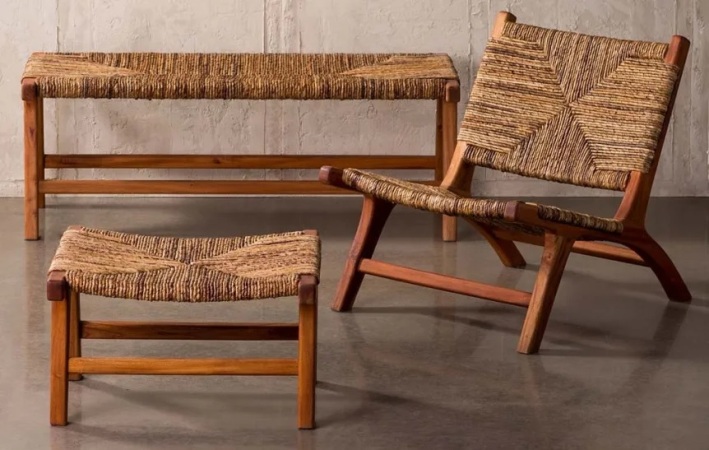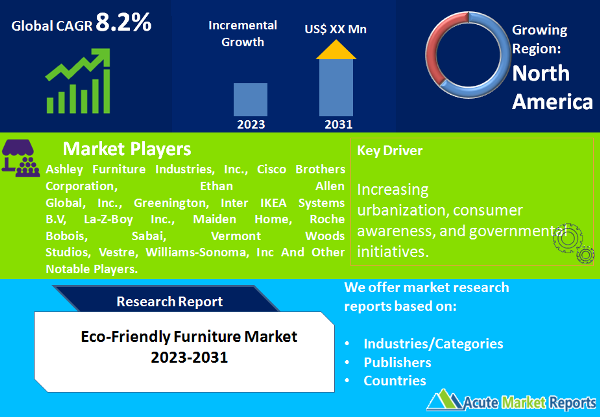
Eco-friendly Furniture market is expected to witness a CAGR of 8.2% during the forecast period of 2025 to 2033. The Eco-friendly Furniture market, a beacon of conscious consumption and sustainable living, has emerged as a dynamic force within the realm of interior design and furnishings. This market's trajectory is a testament to the growing awareness and commitment to environmental preservation. In this comprehensive discourse, we embark on an exploratory journey through the Eco-friendly Furniture market.

Environmental Consciousness and Ethical Consumerism
The Eco-friendly Furniture market is profoundly influenced by the surge in environmental consciousness and the rise of ethical consumerism. The year 2025 bore witness to an unprecedented global awakening regarding the environmental impact of consumption patterns. Consumers have been increasingly seeking alternatives that align with their values of sustainability and responsible resource utilization. This shift in mindset has acted as a catalyst, prompting individuals to opt for furniture pieces that adhere to eco-friendly standards. As environmental stewardship becomes a pivotal aspect of modern living, the demand for furniture crafted with sustainable materials and production methods is expected to steadily rise from 2025 to 2033.
Regulatory Support and Industry Advocacy
Regulatory initiatives and industry advocacy have been instrumental in fostering the growth of the Eco-friendly Furniture market. Governments and regulatory bodies have introduced measures to incentivize sustainable practices across industries, including furniture manufacturing. The year 2025 marked a significant milestone with increased regulations promoting responsible sourcing of materials, energy efficiency, and reduced carbon footprint in furniture production. Simultaneously, industry associations and advocacy groups have played a pivotal role in driving awareness and promoting sustainable practices. These combined efforts have ignited a positive feedback loop, encouraging manufacturers to embrace sustainable processes, thus fostering the market's growth. As we progress from 2025 to 2033, it is anticipated that the collaboration between regulatory support and industry advocacy will continue to propel the market forward.
Consumer Demand for Quality and Durability
Consumer preferences for quality, durability, and longevity have significantly impacted the Eco-friendly Furniture market. In 2024, consumers displayed a growing inclination toward furniture investments that transcend fleeting trends. Eco-friendly furniture, often crafted from robust materials with an emphasis on craftsmanship, aligns seamlessly with these preferences. Individuals are increasingly recognizing the value in owning pieces that not only contribute to environmental preservation but also stand the test of time. This shift in mindset, from disposability to durability, is projected to remain a strong driver for the Eco-friendly Furniture market's growth, as consumers seek sustainable solutions that cater to their functional and aesthetic needs.
Cost Implications and Accessibility
An intricate restraint facing the Eco-friendly Furniture market pertains to cost implications and accessibility. While the benefits of eco-friendly furniture are undeniable, the price point can be comparatively higher than conventional alternatives due to sustainable materials and responsible manufacturing processes. This cost differential can pose a challenge for price-sensitive consumers. Furthermore, accessibility to a wide range of eco-friendly furniture options can be limited, particularly in regions with underdeveloped sustainable infrastructure. While the market has been making strides in addressing these concerns, ensuring a balance between affordability and sustainability remains an ongoing restraint to be navigated.
Steel and Aluminum Dominates Market by Material Type
The segmentation of the Eco-friendly Furniture market based on material type encompasses a diverse spectrum, including Wood, Bamboo, Steel, Aluminum, and Other Recycled Materials. Among these, Bamboo exhibited the highest Compound Annual Growth Rate (CAGR), owing to its rapid growth and renewability. However, Wood, with its timeless appeal and versatile applications, dominated the market's revenue in 2024. In terms of revenue, Steel and Aluminum also held significant shares, reflecting their prominence in creating sleek and durable designs. As the market advances from 2025 to 2033, the material segmentation is poised to adapt to evolving preferences while striking a balance between CAGR and revenue.
Residential Sector Dominates Market by End-user
The segmentation by end-user spans Residential and Commercial sectors, each with distinct market dynamics. In 2024, the Residential sector commanded a substantial share of the market's revenue, as homeowners increasingly prioritized sustainable choices for their living spaces. As the concept of sustainable living gains momentum, the Residential sector is expected to maintain its revenue leadership. Simultaneously, the Commercial sector, encompassing businesses, offices, and hospitality establishments, displayed a noteworthy CAGR in 2024. The growing emphasis on environmentally responsible business practices is projected to sustain this growth trajectory from 2025 to 2033.
North America Remains as the Global Leader
Geographically, the Eco-friendly Furniture market showcases varying trends that align with regional sustainability consciousness. In 2024, North America led both in terms of revenue and CAGR, owing to its robust awareness of environmental issues and affinity for sustainable living. Europe also demonstrated a significant market presence, driven by the region's stringent regulations and cultural emphasis on eco-friendliness. Looking ahead, the Asia-Pacific region is expected to exhibit the highest CAGR, driven by increasing urbanization, consumer awareness, and governmental initiatives. While North America is projected to maintain its revenue leadership, Asia-Pacific's growth is anticipated to reshape the market's landscape.
Competitive Trends
The Eco-friendly Furniture market's competitive landscape is characterized by a cohort of leading players who have positioned sustainability at the core of their brand identity. Renowned companies such as Ashley Furniture Industries, Inc., Cisco Brothers Corporation, Ethan Allen Global, Inc., Greenington, Inter IKEA Systems B.V, La-Z-Boy Inc., Maiden Home, Roche Bobois, Sabai, Vermont Woods Studios, Vestre, and Williams-Sonoma, Inc. have demonstrated their commitment to eco-friendly practices through innovative materials sourcing, ethical manufacturing, and transparency. These companies have leveraged partnerships with sustainable suppliers, invested in renewable energy, and initiated circular economy models. As of 2025, their revenues reflect their dedication to responsible practices, and their strategies from 2025 to 2033 are expected to revolve around strengthening supply chains, pioneering new sustainable materials, and fostering consumer education.
Historical & Forecast Period
This study report represents analysis of each segment from 2023 to 2033 considering 2024 as the base year. Compounded Annual Growth Rate (CAGR) for each of the respective segments estimated for the forecast period of 2025 to 2033.
The current report comprises of quantitative market estimations for each micro market for every geographical region and qualitative market analysis such as micro and macro environment analysis, market trends, competitive intelligence, segment analysis, porters five force model, top winning strategies, top investment markets, emerging trends and technological analysis, case studies, strategic conclusions and recommendations and other key market insights.
Research Methodology
The complete research study was conducted in three phases, namely: secondary research, primary research, and expert panel review. key data point that enables the estimation of Eco-Friendly Furniture market are as follows:
Market forecast was performed through proprietary software that analyzes various qualitative and quantitative factors. Growth rate and CAGR were estimated through intensive secondary and primary research. Data triangulation across various data points provides accuracy across various analyzed market segments in the report. Application of both top down and bottom-up approach for validation of market estimation assures logical, methodical and mathematical consistency of the quantitative data.
| ATTRIBUTE | DETAILS |
|---|---|
| Research Period | 2023-2033 |
| Base Year | 2024 |
| Forecast Period | 2025-2033 |
| Historical Year | 2023 |
| Unit | USD Million |
| Segmentation | |
Product
| |
Material
| |
Price
| |
End-User
| |
Distribution Channel
| |
|
Region Segment (2023-2033; US$ Million)
|
Key questions answered in this report